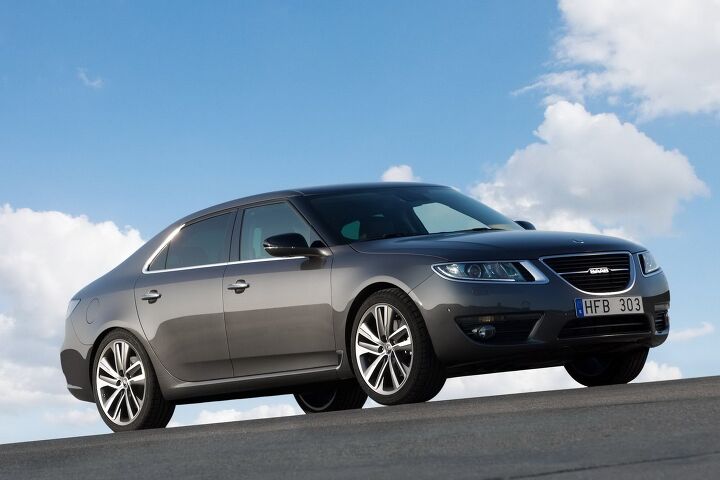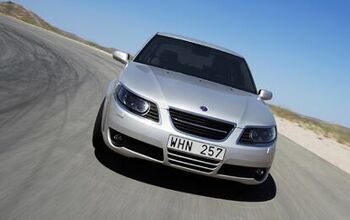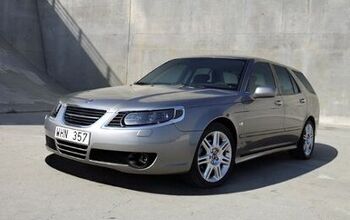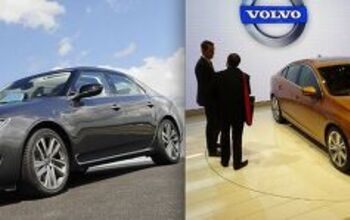Review: 2010 Saab 9-5 Aero
Back in 1983, my father, entranced by its idiosyncracy, nearly bought a Saab 900 Turbo. He even would have bought one, but with Detroit showing new signs of life I was on a “buy American” kick (the decade ultimately cured me). So he ended up buying the second-place finisher in Car & Driver’s infamous Baja comparison test instead. Down the road very different qualities drew him to Lexus. Apparently, Saab wants him back. How else to explain the new 9-5?
The new 9-5 looks about as much like a Saab as a car based on GM’s second-gen Epsilon platform possibly could. The rounded nose, curved windshield, and sweeping C-pillar provide clear visual links to that 1983 900 Turbo. No one will mistake it for the related Buick LaCrosse. And yet, not so Saabish: a high beltline, and the evident size of the car. Compared to the antiquated sedan it replaced, the new 9-5 is over half a foot longer (197.2”) and three inches wider (73.5”). It’s a big car, and appears even larger and more massive than it is. Handsome, perhaps, but neither striking enough nor distinctive enough to draw in new buyers the way the 900 did back in the mid-80s.
To Saab’s credit, they’ve clearly worked hard to retain the marque’s defining characteristics within the new 9-5’s interior. Sweeping fighter jet-inspired IP, egg crate air vents, start button between the seats (now keyless)—all present and accounted for. Aside from the aforementioned high belt, brand loyalists should feel at home. But how many are seeking a car this large, and are willing to spend so much for it? How many Saabistas
are there at this point, period? Nearly everyone else shopping for a $50,000+ sedan is likely to be turned off by the predominance of black plastic. The leather seats look the part, and the design of the door-mounted upholstered armrests is interesting, but these cannot compensate for the stark ambiance and an IP that would look cheap in a car half the 9-5’s price.
Saabs have been blessed with excellent seats since at least 1983, and the new car’s are no exception. The front buckets are firm, yet comfortable, and provide much better lateral support than the typical GM parts. The back seat is nearly as comfortable and very roomy—as it should be given the car’s exterior dimensions. This is the size the S80, with nearly four fewer inches of rear legroom, should have
been. But should the new 9-5 have been the size of the S80?
At launch, the 9-5’s only available powertrain is a 300-horspower turbocharged 2.8-liter V6 driving all four wheels through a six-speed automatic. Even burdened by 4,400 pounds (plus passengers), this engine accelerates the car with no apparent strain. In fact, no apparent anything. Even at the 5,500 rpm power peak the boosted six remains nearly silent. After the drive I popped the hood, expecting to find the engine fully encapsulated. Nothing looked out of the ordinary, but something most certainly is. Partly because of the engine’s almost eerie silence, the car never feels quick.
Given the new 9-5’s size, mass, and genetics, agile handling is out of the question. The active rear differential is no more evident than in other GM applications. On the pavement throttle-induced oversteer will be sought in vain. But understeer is almost equally elusive. For a nose-heavy car, the 9-5 possesses commendable balance and poise, with a tautness you won’t find even in the latest, German-engineered Buicks. The well-weighted steering is firm, especially in “sport mode,” which for once
makes an obvious difference. The 9-5 can be hustled along a curvy road, if need be, and will feel better than the current Mercedes E-Class in the process. For better or worse, it just won’t feel like it’s hustling.
As with the engine, the wind and the road have been nearly silenced. Even the clomping of the tires over road imperfections seems faint and distant. The ride is smooth regardless of which mode is selected—if “sport” had an effect on the auto-adjusting shocks, I didn’t notice it.
I still can’t get my head around a Saab that’s so smooth, so quiet, and so large. There were clearly top priorities. But should they have been? Saab’s Swedish cost structure forces it to charge luxury car prices, so it must provide suitable levels of luxury and refinement. It’s also usually easier to get a higher price for a larger car. But unless a Saab retains the idiosyncracies for which the marque is known, why would anyone buy it? With the styling, and especially the interior styling, they opted to make the new 9-5 distinctively a Saab. But, drive the car, and this styling seems a
veneer over what’s essentially a very well behaved Swedish Lexus. Though not soft like a Lexus, the new 9-5 manages to be surprisingly silent and smooth, and so insufficiently engaging. The evident charisma of that 1983 900 Turbo has been sacrificed. It’s not just Saab, of course. A Mercedes E-Class is completely soulless, and even BMW has been heading in this direction.
But was this “Swedish Lexus” a viable solution for Saab? Perhaps now would have been the right time to once again buck industry trends and truly do their own thing? We’ll probably never know. With the company striking out on its own and hanging by a thread, even most people who might have bought a new 9-5 now won’t.
Michael Karesh owns and operates TrueDelta, an online source of automotive reliability and pricing data
Michael Karesh lives in West Bloomfield, Michigan, with his wife and three children. In 2003 he received a Ph.D. from the University of Chicago. While in Chicago he worked at the National Opinion Research Center, a leader in the field of survey research. For his doctoral thesis, he spent a year-and-a-half inside an automaker studying how and how well it understood consumers when developing new products. While pursuing the degree he taught consumer behavior and product development at Oakland University. Since 1999, he has contributed auto reviews to Epinions, where he is currently one of two people in charge of the autos section. Since earning the degree he has continued to care for his children (school, gymnastics, tae-kwan-do...) and write reviews for Epinions and, more recently, The Truth About Cars while developing TrueDelta, a vehicle reliability and price comparison site.
More by Michael Karesh
Latest Car Reviews
Read moreLatest Product Reviews
Read moreRecent Comments
- BrandX "I can charge using the 240V outlets, sure, but it’s slow."No it's not. That's what all home chargers use - 240V.
- Jalop1991 does the odometer represent itself in an analog fashion? Will the numbers roll slowly and stop wherever, or do they just blink to the next number like any old boring modern car?
- MaintenanceCosts E34 535i may be, for my money, the most desirable BMW ever built. (It's either it or the E34 M5.) Skeptical of these mods but they might be worth undoing.
- Arthur Dailey What a load of cow patties from fat cat politicians, swilling at the trough of their rich backers. Business is all for `free markets` when it benefits them. But are very quick to hold their hands out for government tax credits, tax breaks or government contracts. And business executives are unwilling to limit their power over their workers. Business executives are trained to `divide and conquer` by pitting workers against each other for raises or promotions. As for the fat cat politicians what about legislating a living wage, so workers don't have to worry about holding down multiple jobs or begging for raises? And what about actually criminally charging those who hire people who are not legally illegible to work? Remember that it is business interests who regularly lobby for greater immigration. If you are a good and fair employer, your workers will never feel the need to speak to a union. And if you are not a good employer, then hopefully 'you get the union that you deserve'.
- 28-Cars-Later Finally, something possibly maybe worth buying.




































Comments
Join the conversation
Well I'll give you credit for something original but to say Saab is viewed as a Mitsubishi or Isuzu, with all due respect, is just absurd. Misunderstood and ignorant by most Americans, depending on where you are, but I don't think Isuzu. Of course here in New England Saabs are looked at as different, safe and sporty cars. I've put about 1500 miles on my 2010 9-5 Aero and love driving it more each day. This is my 5th Saab and my 3rd 9-5 Aero, and it's clearly a much more advanced car than the model it's replaced. All the bashing of the car is being done mostly by people who haven't seen it in person never mind drive it for more than 15 minutes. The car drives very European and not Japanese at all. I came from a Lexus SC430 and the Aero out handles it significantly. Sure there is GM DNA in the car, but it was designed and built in Trollhattan, and for me at least it drives like a true sports sedan. I think the marketing plan should be to just get people to test drive the car, remember the old ads that said most people who test drive a Saab end up buying one. With a fully funded 3 year business model the company should make it till the new 9-3, which most people view as the new "all" Saab will be released. Saab has almost always shared technology with competitors. The 2.3 found in the 1ts gen 9-5 was an old Triumph engine. Apparently the new 9-3 may have a BMW engine. I'm happy to be back in a Saab after 5 years with Lexus. Lexus is a fine brand, reliable, well built and in the end quite boring and sterile. There's more in common with the Lexus ride and Buick than any Saab IMHO. So far nobody has asked me how I liked my new Isuzu. JTMav
The reference to Mitsubishi and Isuzu was an analogy. The meaning was that AMONG ITS PEERS (in this case other European, up-market vehicles), it has slipped into being a marginal brand in the US market. Loyalists to the brand may not like this, but the sales #s over the past 15 years don't lie-- even in New England, I suspect. Sorry if the meaning of the prior post wasn't clear.